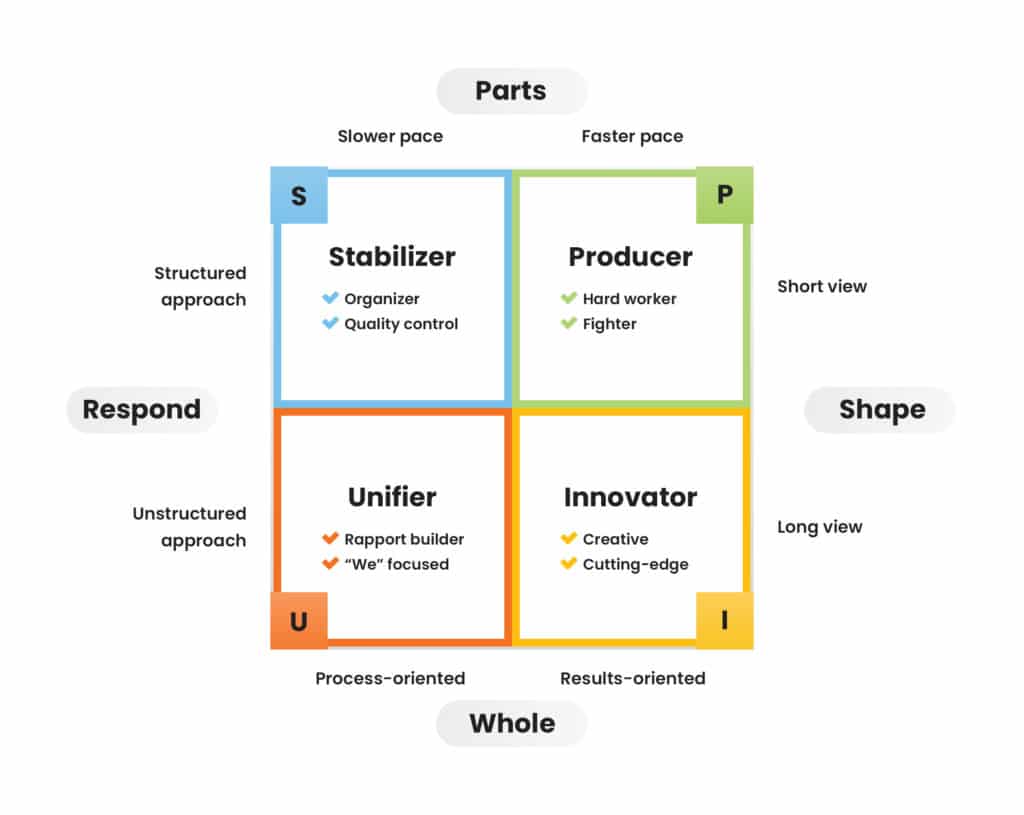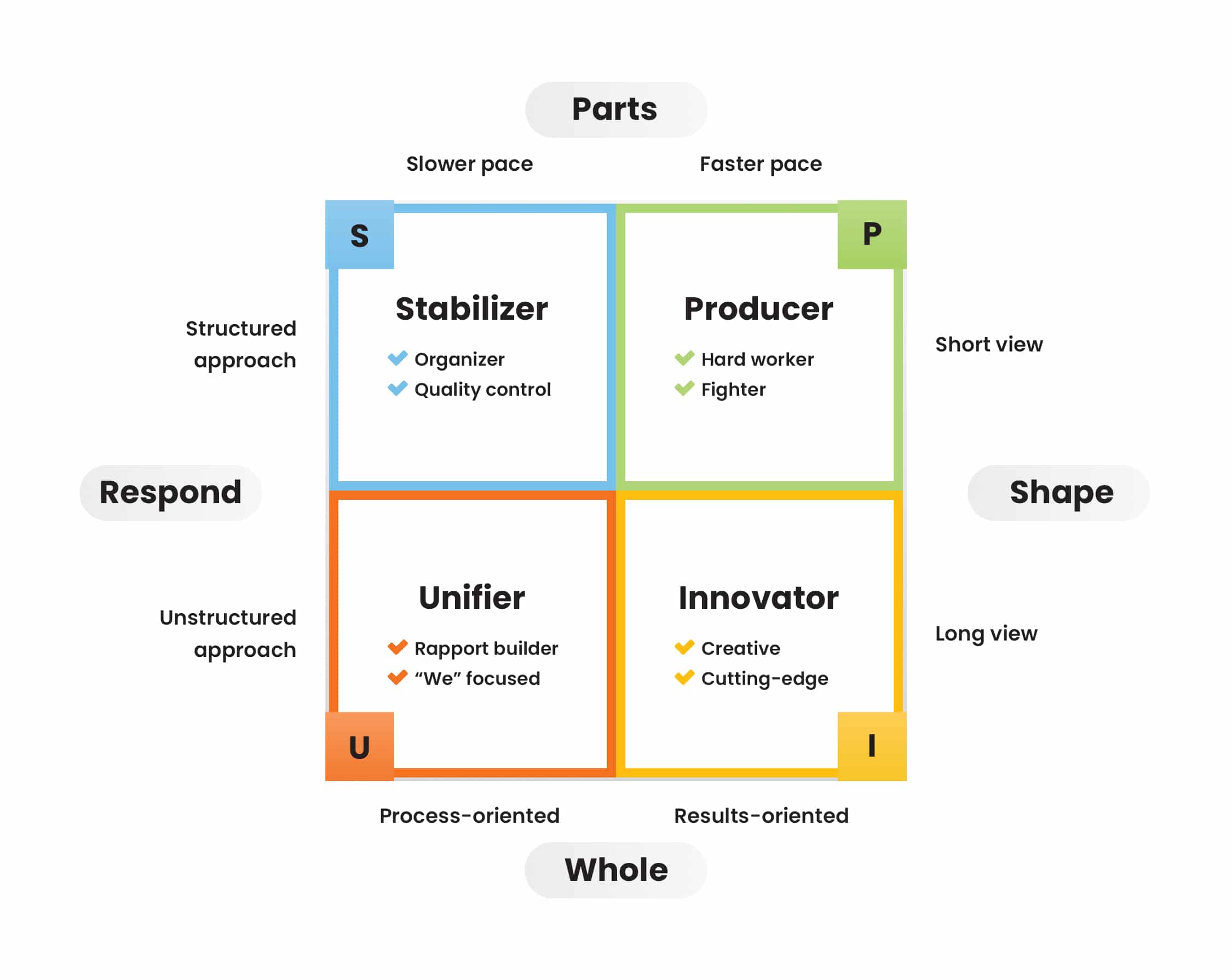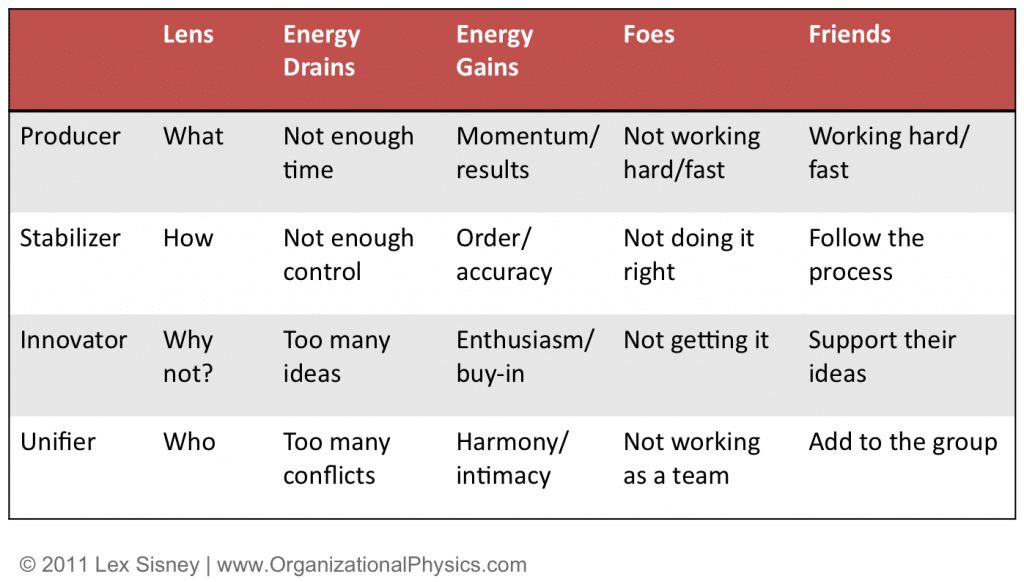Summary Insight:
Your work style isn’t just personality—it’s how you manage energy. Learn to read the four universal forces in yourself and others, and you’ll stop managing people and start orchestrating performance.
Key Takeaways:
- There are four core forces—Producing, Stabilizing, Innovating, and Unifying (PSIU)—and every person expresses a unique blend of them.
- Each style sees the world differently and gains or drains energy based on its environment and habits.
- Managing others effectively means managing energy, not behavior. Start with awareness and give each force what it needs.

What is your work style and how does it interact with other styles? Who’s on your team and how can you help them to reach a higher level of performance? And what about the style of your boss or your spouse – how can you best influence him or her so that you both get what you desire? These are all million-dollar questions. The answers can be found in understanding how the four forces — Producing, Stabilizing, Innovating, and Unifying — operate within each of us.
Each of us expresses a certain work style – understood in its broadest sense as a mode of operating in the world – that reflects our own unique combination of the Producing, Stabilizing, Innovating and Unifying Forces. All four forces are present in each of us in some form, but usually one or two of them come to us most naturally. In addition, when one force is relatively strong, one or more of the others forces will be relatively weak.
While we may modify our general style depending on circumstances, stepping out of our natural strengths costs us more energy than operating within them. For example, imagine a highly innovative entrepreneur who is forced to do bookkeeping for a week. Sure, she may be able to do it, but she’s also going to feel extreme tedium, effort, and a loss of energy as a result. It’s because of this energy cost that most of us express fairly consistent characteristics that reflect our usual way of managing. Effective management therefore requires understanding your own style and its relative strengths and weakness, as well as that of the people with whom you work and interact.
The chart below shows how each basic work style compares to the others. It compares the pace (slow to fast) of how a style tends to act, think, and speak; the time frame (short view to long view) of how a style tends to perceive a situation, trend, or idea; the orientation (process-oriented to results-oriented) of how a style tends to relate to people and situations; and the approach (structured to unstructured) of how a style tends to operate in daily tasks.

The Producer
The Producer (P) has a high drive to shape the environment and is focused on the parts that make up the system. Thus, this style moves at a fast pace, takes a short-term view, is results-oriented, and follows a structured approach. The Producer is focused on what to do now and working hard to get it done quickly. To get an immediate sense of the Producer’s qualities, think of a fast-charging, focused, determined, high-energy person who thrives on working long and hard. That’s a Producer.
The Stabilizer
The Stabilizer (S) has a high drive to respond to the environment and is focused on the parts that make up the system. Therefore, this style moves at a slower pace, takes a short-term view, is process-oriented, and follows a structured approach. The Stabilizer is focused on how to do things and working methodically to get them done the right way. To get an immediate sense of the Stabilizer’s qualities, think of a very structured, process-oriented person who likes to analyze the data before making a decision. This person is highly organized, has outstanding attention to details, and takes their time in their words and actions. That’s a Stabilizer.
The Innovator
The Innovator (I) has a high drive to shape the environment and is focused on the whole system. Consequently, this style moves at a fast pace and is results-oriented like the Producing Force, but takes a long view and operates in an unstructured way. The Innovator is focused on driving change while finding new and better ways of doing things. The lens they use to view the world is, “Why not?” As in, “Why not do it this way?” or “Why not try putting these two things together?” To get an intuitive sense of the Innovator’s qualities, think of a dynamic, creative, big-picture person who has myriad new ideas and is usually excited by the latest one – until a new one strikes again. That’s an Innovator.
The Unifier
The Unifier (U) has a high drive to respond to the environment and is focused on the whole system. Therefore, a Unifier moves at a more measured pace and is process-oriented like the Stabilizer, but takes an unstructured, freewheeling approach and a long view of change like the Innovator. The Unifier is primarily focused on who is involved and the interpersonal dynamics of the group. To get an immediate sense of the Unifier’s qualities, think of a very likeable, gregarious, warm, people person who is in tune with others. That’s a Unifier.
A Note About Language: When a person or organizational function has, or requires, a strong Producing Force, it is referred to as a “Producer” or “P.” A strong Stabilizing Force is referred to as a “Stabilizer” or “S.” A strong Innovating Force, an “Innovator” or “I.” A strong Unifying Force, a “Unifier” or “U.” As a mnemonic aid, think “PS I love U” and you’ll remember the four forces: PSIU. In addition, strong and weak forces are distinguished by capital and lowercase letters, respectively. For example, a strong Producer is written: Psiu. A strong Innovator is written: psIu. A person or role that has or requires a strong Producer and Stabilizer is written: PSiu. And so on. This nomenclature is in recognition that every system needs all four forces and that not all four forces exist in balance.
Meshing of Styles
Most mature, healthy adults aren’t extreme versions of a singular style. Instead, they exhibit a range of styles depending on their current life conditions and level of self-development. In my experience, people generally seem to be born with one or two primary styles, can develop a third over time, and are usually weakest in one style throughout their lives. For example, if you were born with a high drive and high creativity, your style is PsIu. If you’ve learned to develop your stabilizing qualities over time through the demands of your school or work, you might show up as a PSIu. However, you’ve always been an introvert and enjoy alone time, so the U is the weakest of your styles. No amount of personal or professional development is going to change that relative balance.
Because all four forces compete for a finite amount of energy, if you are born a P and have matured into a U, that will mean that one of the other styles has backed off in predominance over time. For instance, I have a successful friend who was a PsIu (a typical entrepreneur style) for much of his career. He built and sold several companies. He’s mellowed and matured over time. Today, he shows up more like a psIU. He’s friendly, gregarious, creative, and loves to mentor others. That is, as his U qualities developed over time, his P qualities lessened. It would take tremendous energy and effort for him to reengage his former P qualities to do another start-up again.
As you meet people in your life and work, you’ll notice some common patterns emerging among different career types. Here are some common examples:
Entrepreneur. Good entrepreneurs have an ability to see the future and act to make it happen (PsIu). They have a very well-developed Innovator capability that allows them to see and anticipate how trends will converge in the future. They’re not just visionary, however; they also have the willingness and drive to take action on that vision and produce results now to make it happen. As the company grows, a great challenge for most entrepreneurs is when and how to shift out of working in the business to working on the business. More on this in other sections.
CEO If an entrepreneur is going to evolve into a CEO, then they’ll need to develop either their S (PSIu) and be a shrewd and calculated operator or develop their U (PsIU) and be a visionary who can rally a larger company and market to their cause. There’s a popular notion among management circles today on the difference between a “wartime” and a “peacetime” CEO. The basic difference is that in a time of crisis, contraction, or “war,” a company needs a CEO who can analyze the situation, make a bold decision, and be ruthless in execution (PSIu). But in times of expansion and growth, or “peace,” the company needs a CEO who can build bridges, form alliances, and find new growth opportunities, all while executing on the quarterly goals (PsIU).
Implementer. An implementer (PSiu) is someone who can work really hard and be highly organized. You’ll find them thriving in tasks that require effectiveness and efficiency in high-pressure situations. If this person wants to evolve their career, they can develop their U (PSiU) and become an Operator or a person who can drive results, manage the details, and coalesce a team — very valuable skills for a chief operating officer.
Sales. A good sales person has a high drive to produce results and thrives on winning (Psiu). However, you’ll meet many different styles of sales people. There’s the PsiU who is a great sales manager because they walk the talk and coalesce the entire sales team. There’s the PSiu who is outstanding at working hard, producing accurate contracts, and creating and following a scalable sales process. Compare this to a good client relationship manager who should demonstrate pSiU in that they can follow a process, keep the client on track, and at the same time have great interpersonal relationships.
Engineering. Engineers come in many different types. If your organization uses traditional waterfall engineering, then you’ll want an engineer who can work hard and follow the documentation and standards (PSiu). However, if you use an agile methodology, then you’ll want an engineer who works hard and is a great team member (PsiU) or is highly creative (PsIu), while following a sound agile process that provides the S for the team to follow. A good code for a scrum master would be (PSiU). In this case, they work hard and gain the respect of the team (P), can create and follow a sound process (S), and keep everyone on the same page (U).
Friends vs. Foes | Gains vs. Drains
One way to intuitively grasp the basic characteristics of each work style is to recognize who it tends to view as friends (those they admire, respect, value, etc.) versus foes (those they devalue, discount, disrespect, etc.) as well as what tends to cost it energy (emotional drains like stress, anxiety, frustration, etc.) versus give it more energy (emotional gains like satisfaction, happiness, confidence, etc.).
The Producer views the world as what to do. The energy drains for a Producer are the feeling of not having enough time to accomplish all of the work. And guess what? The Producer always has too much work to do. In addition, it is their own internal clock that determines when work should be accomplished. The energy gains happen when the Producer has a feeling of momentum and achieving results in their tasks and goals. Producers tend to like others who work as hard and as fast as they do and dislike people who don’t.
The Stabilizer views the world as how to do things. The energy drains for a Stabilizer occur when they don’t feel they have control over a situation. They experience energy gains like confidence and happiness when things as orderly and accurate. Stabilizers like people who are accurate and thorough and dislike those who are not.
The Innovator views the world as possibility. They ask, “why not?” The energy drains for an Innovator are having too many ideas to pursue. This may seem counter-intuitive because Innovators love ideas. When they generate too many ideas, however, it’s like they can’t find their way out of a paper bag. The gains for an Innovator occur when one of their ideas takes hold and really works! Innovators like people who give them support. This support could be as simple as excitement and encouragement for their latest idea or support from investors and employees who buy into their vision. Innovators dislike people who don’t support their ideas.
The Unifier views the world from the perspective of who is involved. Because Unifiers value harmony in the system, they experience energy drains when there is too much conflict and gains when everyone is on the same page and working well together. The friends are those who add to the team chemistry and interpersonal dynamics. The foes are those who create conflict and destroy harmony in the system.
There is much more you can tell about a person by just knowing their style. These include their preferences in language, personal workspace, what they tend to miss, how they view other styles, what they truly enjoy, what they like to be praised for, how they address problems and make decisions, what they excel at, and what makes them most satisfied (I’ll share more about these in future posts). As you’ll see, when you recognize your own style and that of others, you’ll find managing, influencing, and collaborating with others much, much easier.
The Cause of Different Styles
So what is the cause of different work styles? Why does one person act differently than another in any given situation? Obviously there are many, many factors that influence why a person behaves the way they do. There’s genetics, environmental factors, personal history, family history, education, culture, and much more. But there’s one fundamental factor that plays a role for each of us. In a word: Energy.
Here’s why. Every system (people, organization, etc.) operates with a finite amount of energy. We conserve our available energy to maintain ourselves, make decisions, and get work done. In order to survive and flourish, we must get new energy from the environment — just as you must get oxygen from the environment while reading this, or a business must get new revenues from its clients in the marketplace. It is this quest for new energy that compels us to shape and respond to the environment and to do so as a whole organism, including the parts and sub-parts. If not, our system will cease to get new energy from the environment and it will perish.
In an attempt to make the most efficient use of our available energy, we develop habits. Our habits are unconscious patterns that govern how we interact with ourselves and the world. When we’re dealing with a lot of change, for example, it generally costs us more energy to manage. When we can make our actions into habits, we have more energy available to attempt to be in integration with the outside world. That’s why professional athletes practice for hours on end – so that the perfect swing becomes second nature. They don’t have to think about it. It costs less energy.
Our work style, therefore, is formed over time and becomes a habit because it is how we learned to cost-effectively shape and respond to the world while managing all of the parts and sub-parts that make up the totality of our systems. That’s why a Producer tends to get more energy by working hard and feels stymied when obstacles are in their path. That’s why a Stabilizer tends to get more energy by creating order out of chaos and feels overwhelmed when there’s not enough control. That’s why an Innovator prefers to drive change – it gives them energy – and why they feel drained when others don’t enthusiastically support their latest ideas. And it’s why a Unifier likes to maintain harmony and low conflict – it costs them less energy than disharmony and high conflict.
How You Can Use This
Identifying the four forces not only allows you to quickly discern what’s really happening; it also helps you gain self-awareness and better accept yourself, others, and the situations around you. At the same time, it improves your ability to orchestrate win-win situations by giving whatever you’re managing what it really needs. And this will make your life a lot easier, more satisfying, and even more fun.
Next, register for the PSIU Talent Management Suite and discover your own work style and much more…
Back to Tutorials.





